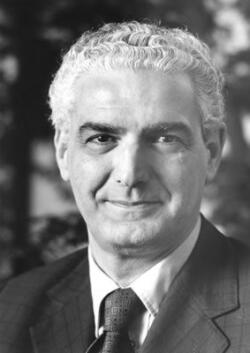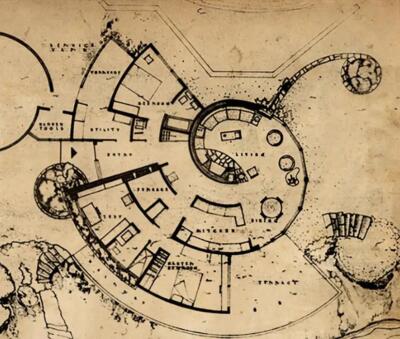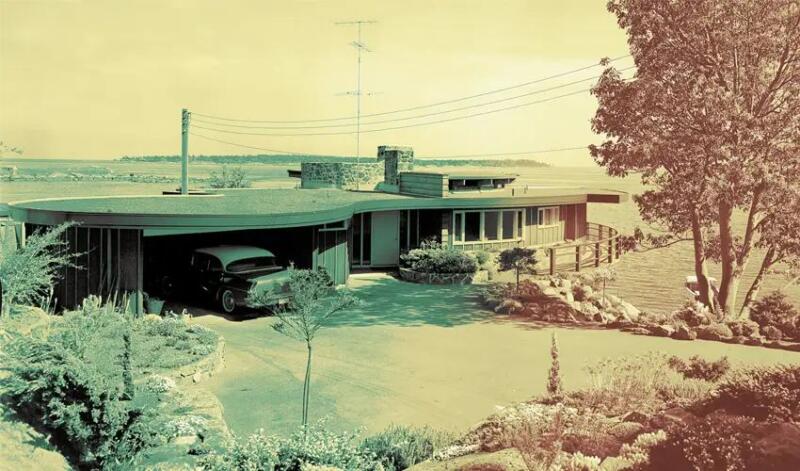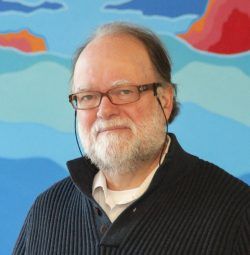Pioneer of ‘West Coast Modern’
Exhibition: John Di Castri, Architect
A Retrospective (1924-2005)
Reviewed by Martin Segger
*

Photo courtesy Wentworth Villa Architectual Heritage Museum
[Editor’s Note:The Victoria career of mid-century Modernist architect, John Di Castri, was featured in an exhibition at Wentworth Villa Architectural Heritage Museum in Victoria. It was sponsored by the Royal Architectural Institute of Canada, and co-curated by local architect Chris Gower RAIC and Martin Segger Hon. RAIC, working with design arts specialist Allan Collier and Wentworth Director, Ben Clinton-Baker. Photographs, drawings, paintings and architectural models covered over 50 years of Mr. Di Castri’s highly creative practice. The exhibit featured dozens of his local commissions, from churches, schools, commercial buildings and shopping malls to residences. Wentworth Villa Architectural Heritage Museum is the brainchild of two Victoria philanthropists and heritage advocates, Magda and Stefan Opalski. Recent retirees from Ottawa, the two were enamoured with Victoria’s rich architectural history. They completely restored an 1860s landmark house for the museum and a small chamber music concert hall. The galleries feature a series of architectural models depicting major Victoria historic houses and the personalities that designed, built and lived in them.]

Even among the group of young architects who were transforming Victoria’s post-war urban landscape in the 1950s and ’60s with their ambitious Modernist designs, John Di Castri was an outlier.
Born in Victoria, Mr. Di Castri was raised in an Italian immigrant family. His father was a band master and voice coach. But John’s own early ambitions for a career as a concert pianist gave way to the reality of family finances. On graduation from Victoria High School John joined the Provincial Government Public Works Department as a trainee draughtsman.
By 1949 he was a senior technician in the practice of Birley Wade and Stockdill, but decided to take time off for studies at the University of Oklahoma to work under Bruce Goff (1904-1982), a noted leading disciple of American architectural icon, Frank Lloyd Wright (1967-1959). Goff immersed his students in a radical brand of highly innovative expressionist design, pushing Wright’s ‘organic’ legacy to new limits. Mr. Di Castri’s graduation thesis, a proposed community arts centre for Oklahoma City, amalgamated notions of sci-fi futurism, an idealized creative community, along with as-found urban planning.
Returning to Victoria after a cross-continental tour of F. L. Wright’s major commissions (including meeting the great man himself at his architecture school, Taliesin West, in Arizona) Mr. Di Castri established his own practice in 1951.
Responding to the expansionist economics of the Province, Victoria was poised at the edge of a multi-decade building boom as the “boomer generation” itself came of age. Aspirations were unbounded. Set against the rationalist strains of the prevalent local Modernism which mainly referenced the work of Europeans, particularly the spare clean lines of British and Scandinavian architects featured in the literature of the day, John’s designs were creative, even flamboyant. His work celebrating the rugged treed landscapes of the region and the rich palette of local building materials.

While a noted pioneer of what we now call “West Coast Modern” Mr. Di Castri could never be constrained by the minimalism of his contemporaries. Often John would establish a theme drawing from nature such as intersecting curves (Smith House 1952) or the form of a seashell (water-front Dunsmuir residence 1953).

A major breakthrough came with the commissioning of The Trend House. It was one of ten demonstrations houses commissioned by the B.C. Coast Woods Extension Bureau. His design was immediately celebrated as the most innovative. In it he pushed materials and technology to the limit. A polygon plan supports a diamond-form roof-truss system which seems inspired by wooden airframe technology. A massive masonry chimney slices diagonally through the body of house as if to pinion the complex roof forms in flight. Exterior wood and masonry finishes are carried through to the interior. All these elements would become Mr. Di Castri design hallmarks.
Raised a Roman Catholic, he was noted for his many church commissions. His last commission for the University of Victoria was a multi-faith Chapel. The congregate space sheltering beneath the generous spread of it dominant hipped roof brings together gardens and woodland-forest references a traditional Victoria house-form: the colonial bungalow, and beyond that the symbolism of the ancient Bronze Age “sacred hut”. Many of his commissions also reveal a profound meditative quality, a sense of the sacred which informs the iterative manipulation of spaces, forms and textures.
In a statement prepared for an exhibition of his work during his life-time Mr. Di Castri wrote: “People yearn for buildings which are based on the timeless standards of beauty, quality, harmony and integrity. We must not only desire these standards but demand them of all those responsible for the built environment, including the whole political structure which permits the type of communities we now have.”

*

Martin Segger is an architectural historian, writer, and urban critic. He has written extensively on Victoria’s built environment. Author of numerous publications on the architectural history of BC, including (with Douglas Franklin) the path-breaking Victoria: A Primer for Regional History in Architecture 1843-1929 (1979), he also enjoyed a long career as a gallery curator focusing on BC historic and decorative arts. He is group-coordinator of the UNESCO Victoria World Heritage Project. Editor’s note: Martin Segger has recently reviewed books by Raymond Biesinger & Alex Bozikovic, Allen Specht, Liz Bryan, Michael Kluckner, Marc Treib, and Daina Augaitis, Allan Collier & Stephanie Rebick for The British Columbia Review.
*
The British Columbia Review
Interim Editors, 2023-24: Trevor Marc Hughes (non-fiction), Brett Josef Grubisic (fiction)
Publisher: Richard Mackie
Formerly The Ormsby Review, The British Columbia Review is an on-line book review and journal service for BC writers and readers. The Advisory Board now consists of Jean Barman, Wade Davis, Robin Fisher, Barry Gough, Hugh Johnston, Kathy Mezei, Patricia Roy, Maria Tippett, and Graeme Wynn. Provincial Government Patron (since September 2018): Creative BC. Honorary Patron: Yosef Wosk. Scholarly Patron: SFU Graduate Liberal Studies. The British Columbia Review was founded in 2016 by Richard Mackie and Alan Twigg.
“Only connect.” – E.M. Forster
One comment on “Pioneer of ‘West Coast Modern’”